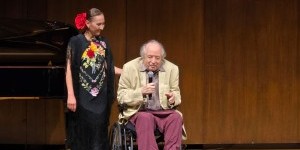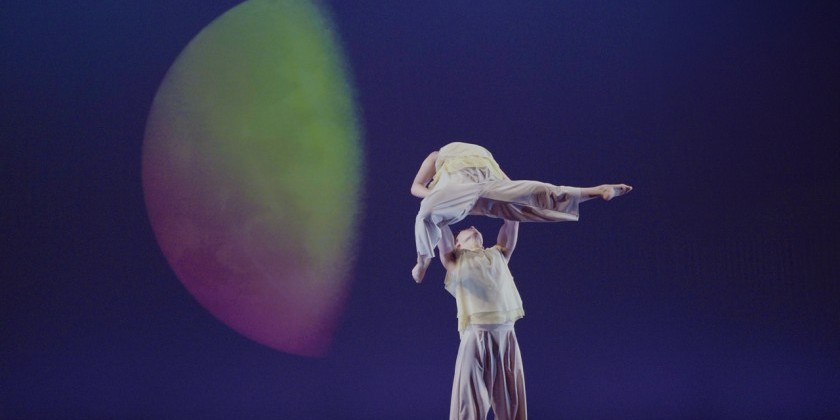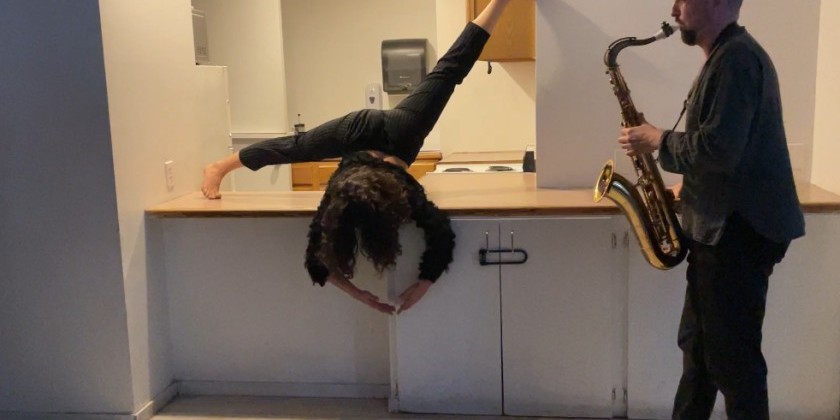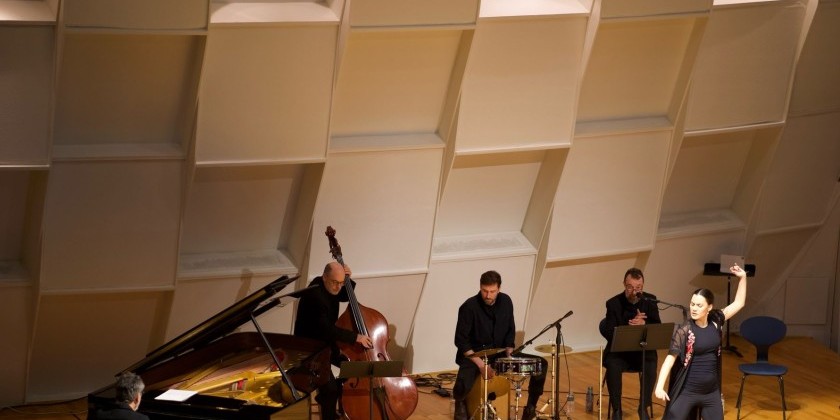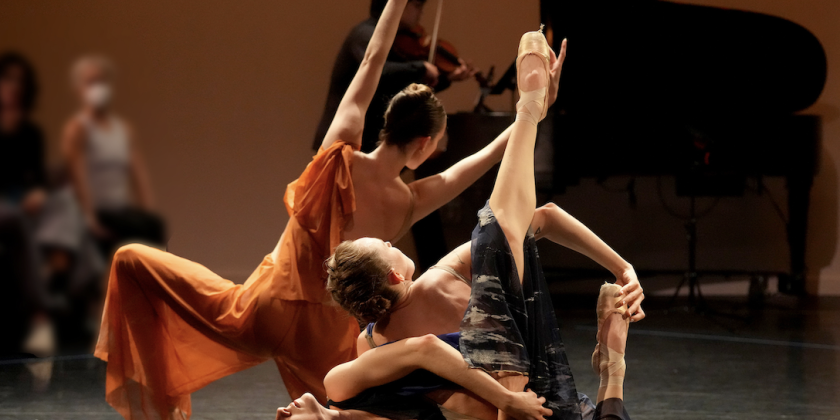AUDIENCE REVIEW: Pilobolus at The Joyce
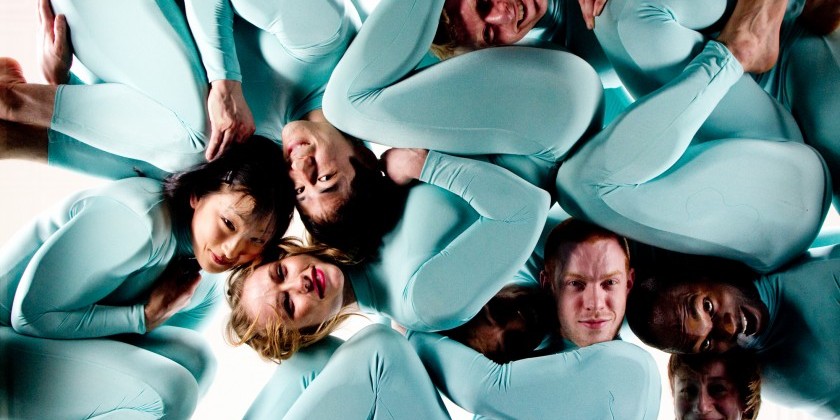
Company:
Pilobolus Dance Theatre
Performance Date:
Wednesday, July 30, 2014
Freeform Review:
Pilobolus Dance Theatre is highly known for innovative collaborations with creative services (their unforgettable performance at the 79th Annual Academy Awards being one of the most notable), but it is definitely no stranger to the New York dance stage. The company performs annually at The Joyce; the two alternating programs that make up this year’s season run through August 10th. Last week, I had the pleasure of attending Program B, which presented a night of humorous theatrics and jaw-dropping movement. The program is well thought-out, alternating between the lighter, character-driven works and more extreme, acrobatic dances. The five works that make up thisjam-packed night exemplify the diversity of Pilobolus repertory, and when strung together as a program neither overwhelm the audience with movement, nor underwhelm us with solely gesture-driven characters. The whim and lighthearted humor that serves as a throughline for the entire program is refreshing: a reminder that even in its dance-heavy works, the company does not take itself too seriously.
As the audience files into The Joyce, the seven dancers that make up the company are already warming up onstage: walking on their hands, practicing dynamic weight shifts, diving in and out of the ground. They exchange friendly glances with one another and, every once in a while, look out into the audience to wave to a loved one. This entire scene immediately engages the audience and establishes the evening’s program as an approachable experience. The dancers invite us into their world before it even begins: giving us hints of the incredible movement that is to come, but showing us the steps they take to get there. This humanization onstage does not stop with the dancers: a visible stage crew sports Pilobolus t-shirts as they move the set pieces between each work. Though they present other worldly bits of theatre, nobody in Pilobolus is trying to hide how the magic happens.
The program opens with Masters of Ceremony, performed by the company’s Associate Artistic Directors, Renee Jaworski and Matt Kent. This quick and clever work of dance-theatre explores the relationship between a show animal (Kent) and his master (Jaworski). The third character in the work is a long rope, which keeps the duo together despite the independent movements and acrobatic stunts each dancer performs against his or her counterpart. The duo appears to know their movement regiment quite well: they move through Kent’s runaway attempts and Jaworski’s ruthless disciplinary actions as if it is their characters’ second nature. This Vladimir and Estragon-like cycle of repetition reveals their constant desires to assert power over one another, but also shows their awareness of this unique co-dependent relationship. Jaworski and Kent’s incredible physical abilities are not lost within their commitment to the characters; both artists prove why the company is called Pilobolus Dance Theatre.
Next on the program is All is Not Lost: the live companion to a video collaboration the company completed with Grammy Award-winning band OK Go (see the video here: https://www.youtube.com/watch?v=ur-y7oOto14&feature=youtu.be). In the proscenium version of the work, the right half of the stage contains an upward facing video camera placed underneath a metal table with a clear top,. When the dancers climb onto this table, their images are projected on a screen set to the left. This split in playing areas creates somewhat of a two-ring circus on stage: we can choose to focus our attention to the screen to watch the quirky faces and asymmetrical shapes the dancers make atop the camera; or watch the right side of the stage, where the pouring of bodies on and off of the table is a dance within itself. We also have the treat of witnessing the dancers smile and bop to OK Go’s music with one another as they wait their turn for a go on the table: another example of all-encompassing and revealing nature of the production in Pilobolus.
The lightheartedness established in these two shorter works carries into the program’s lengthier dances: Korokoro and Megawatt. Both works feature the acrobatics Pilobolus is readily associated with, and prove the necessity of those practices we saw during the onstage warm-up. Korokoro, which closes the first act, reminds the audience just how limitless the bodies of Pilobolus dancers are: they intertwine their limbs, inflate their bodies, and fall in and out of one another’s weight with what seems like minimal effort. The work packs a bit too many ideas into one setting, but the movement is breathtaking and is complimented nicely by John Kane’s projections of wildlife and urban settings.
The audience erupts in roaring cheers for Megawatt; this show-stopping finale is clearly a crowd favorite. We wait in fervent anticipation as Primus’s Here Come the Bastards blares and the lights reveal an empty stage, lined with tumbling mats and secured with fluorescent lights on the perimeter. These twenty seconds of emptiness leave us to only imagine what jaw dropping acrobatics we can expect to match this heavy rock n’ roll music and careful stage setting. The dancers luxuriate in this suspense, taking their time to enter by thumping on their backs to the beat. “Here they come”, indeed. They are electrocuted onto their feet and then into air with spellbounding acrobatics, reaching an all-time energy high that they maintain for the entirety of the work.
The program’s true delight is the company’s New York premiere: The Inconsistent Pedaler, created in collaboration with Israeli writers Shira Geffen and Etgar Keret. Pedaler reveals the dysfunction that ensues when one sole person is forced to carry an entire family unit’s burdens by pedaling its members through life. The inanimate character in this work is a stationary bike, which lives downstage of the main scene: the 99th birthday party of the hilarious Shawn Ahern. Jordan Kriston portrays the story’s pedaler, and she locomotes the bicycle to keep her family (doting mother and father Eriko Jimbo and Benjamin Coalter, along with the mischievous, diaper wearing baby Nile Russell) at ease. The flying cake/fallen banners/coital parents/runaway grandpa-related chaos that occurs when Kriston steps off her bicycle is a delight to watch, and while the family’s collective melt that suggests their lives will stop if she does not continue to pedal is melodramatic, it is fitting for the tone of the work.
Throughout, we are invested in this family, particularly in Ahern, who both warms and breaks our hearts with his desire to take an active role in the scene. His earnest attempts to pedal the bicycle himself--including maneuvering the pedal with his hands while upside down on the seat, and biting the handlebars to keep himself balanced--have the audience reeling in laughter. When the family (along with the suave Matt Del Rossio, who enters the scene to show Kriston she does not have to pedal alone) helps Ahern finally go for his bike ride, we are overjoyed. Above anything else, the message of Pedaler is a beautiful one. It confronts the issue of taking too much responsibility for one’s family, and embraces that innate desire to provide for those we love.
— Hilary Kooistra
Image: "All Is Not Lost"/Pilobolus. Credit Nadirah Zakariya





